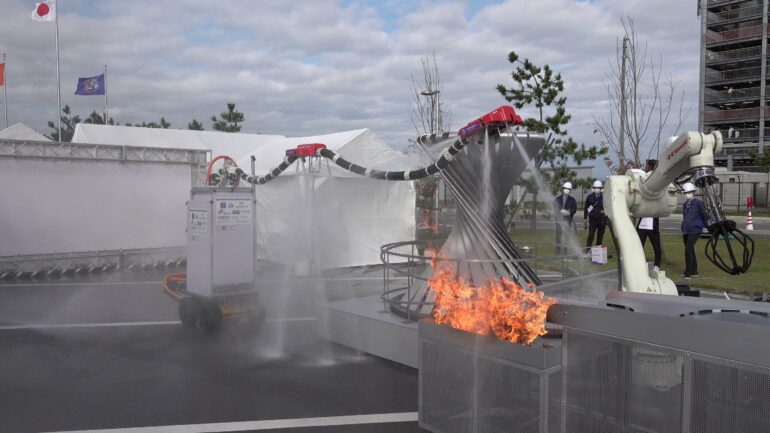Imagine a flying dragon that doesn’t spout fire, but instead extinguishes it with blasts of water. Thanks to a team of Japanese researchers, this new kind of beast may soon be recruited to firefighter teams around the world, to help put out fires that are too dangerous for their human teammates to approach.
The blueprint of this novel firefighter robot, called the Dragon Firefighter, has been published in Frontiers in Robotics and AI. And as it has been published as Open Science, roboticists around the world may freely use the plans to build their own Dragon Firefighters, for the benefit of all.
“We here present a prototype of a four-meter-long, remotely controllable flying firehose robot, engineered to safely and efficiently extinguish fires in buildings by directly approaching the fire sources,” said joint corresponding author Dr. Yuichi Ambe, an assistant professor at Osaka University.
A research team from Prof Satoshi Tadokoro’s laboratory at Tohoku University began working on similar flying robots in 2016. Since then, 11 researchers and students have contributed to its further development. Prior and during development, they liaised with Japanese firefighters to better understand their needs.
Jet propulsion
The Dragon Firefighter’s firehose is propelled upward (flying at two meters above the ground) by eight controllable jets of water spouting from its center and head. The firehose can change shape and be oriented towards flames, steered by a control unit in a wheeled cart behind. The cart is connected through a supply tube to a fire truck with a water reservoir of 14,000 liters.
The nozzles spout water at a rate of 6.6 liters per second with a pressure of up to one megapascal. The hose’s tip contains a conventional and thermal imaging camera, which help to find the location of the fire.
The Dragon Firefighter received its baptism of fire at the opening ceremony of the World Robot Summit 2020 (WRS2020), held in September 2021 in Fukushima. There, it successfully extinguished (49 min 00 s to 51 min 00 s) the ceremonial flame, consisting of fireballs lit by another robot, at a distance of four meters. Besides detailing its design, the present study also discusses lessons learned during this first demonstration of the Dragon’s abilities, as well as specifying further improvements made since.
Dr. Yu Yamauchi, an assistant professor at Akita Prefectural University and another corresponding author, said, “Since the demonstration at WRS2020, we have continued to work on improving our Dragon and have learned many new things.”
“For example, we found that the original passive dampening mechanism which counters oscillations of the Dragon Firefighter’s body was impractical: it took too long to prepare for flight. We also found that heat from fires can cause detrimental plastic deformation in outdoor applications of the corrugated tube that holds the water hose and electric cables.”
Other improvements detailed in the study include better waterproofing, a nozzle unit capable of handling a wider range of net forces, and an improved mechanism for channeling water flow. But further developments are in the pipeline.
Ready to fly in 10 years
“We estimate that it will take approximately 10 more years to deploy our robot in real-world firefighting scenarios,” said Ambe.
“The primary challenge will be to extend its reach to beyond 10 meters. Developing effective firefighting tactics tailored to this robot’s unique capabilities will likewise be a critical aspect of further development.”
More information:
Development of a remotely controllable 4 m long aerial-hose-type firefighting robot, Frontiers in Robotics and AI (2023). DOI: 10.3389/frobt.2023.1273676
Citation:
Scientists develop ‘flying dragon’ robot to fight fires from a distance (2023, December 22)



